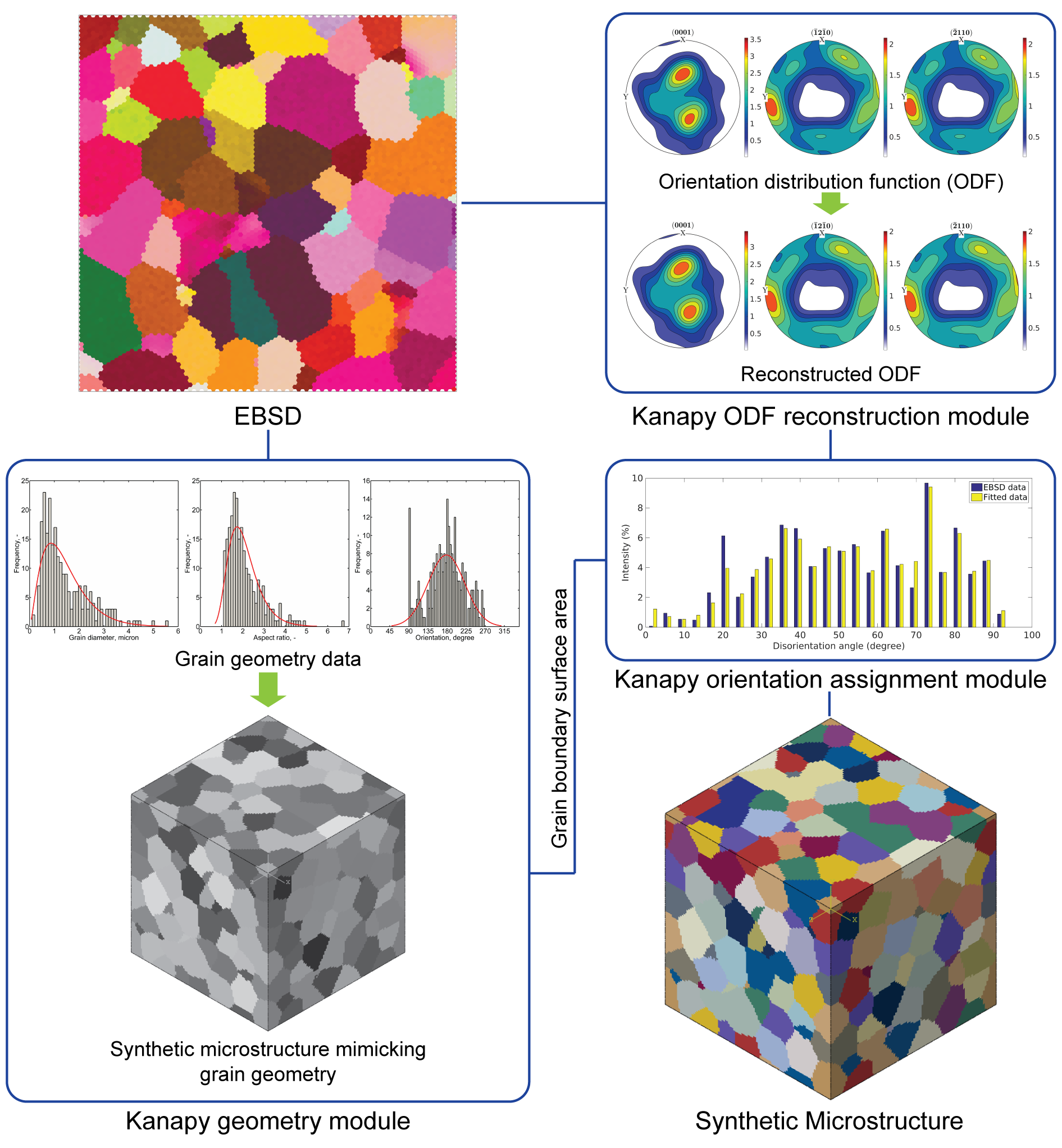Overview¶




Kanapy is a python package for generating complex synthetic polycrystalline microstructures. The general implementation is done in Python with the performance critical part for the geometry module implemented in C++. The Python bindings for the code written in C++ are generated using the lightweight header-only library pybind11. The C++ part of the implementation utilizes the Eigen library for efficient linear algebra calculations. The texture module of Kanapy is implemented as MATLAB functions. It also utilizes several algorithms implemented in MTEX for texture analysis.
Motivation¶
An accurate representation of the material microstructure is fundamental in understanding the relationship between microstructure and its corresponding mechanical behavior. In this regard, Kanapy is developed to be a robust and an efficient tool to generate synthetic microstructures within the micro mechanical framework for Finite Element Method (FEM) simulations. It is designed to model simple and complex grain morphologies and to systematically incorporate texture data directly from experiments concurrently maintaining the numerical efficiency of the micromechanical model. Kanapy is developed to overcome the limitations of spatial tessellation methods and to provide an alternative to the existing Random Sequential Addition technique of microstructure geometry generation.

Figure: Kanapy workflow.¶
Features¶
User interface to kanapy through CLI.
Efficient collision handling of particles through a two-layer collision detection method employing the Octree spatial data structure and the bounding sphere hierarchy.
Efficient ODF reconstruction directly using orientations from experimantal data.
Optimal orientaion assignment based on Measured misorientation distribution.
Independent execution of individual modules through easy data storage and handling.
In-built hexahedral mesh generator for complex polycrystalline microstructures.
Flexibility in the choice of the particle packing time step to be sent for voxelization (meshing).
Option to generate spherical particle position- and radius files that can be read by the Voronoi tessellation software Neper.
Option to generate input files for the commercial finite-element software Abaqus.
High-performance for the critical part of the geometry code using Python-C++ bindings.
Installation¶
The preferred method to install kanapy is through Anaconda or Miniconda Python distributions. If you do not have any, we suggest installing miniconda.
Once done, create a virtual environment for Kanapy installation and clone the repository to a desired location and install.
$ conda create -y -n knpy python=3.6 pip git
$ conda activate knpy
(knpy) $ git clone https://github.com/mrgprasad/kanapy.git <location to clone>/kanapy-master
(knpy) $ cd kanapy-master/
(knpy) $ conda install -y -c conda-forge --file requirements.txt
(knpy) $ pip install -e .
Kanapy is now installed along with all its dependencies. If you intend to use Kanapy’s
texture module, link Kanapy with MATLAB and MTEX installations by
running: kanapy setupTexture and follow the instructions.
Note
knpycan be replaced with any name for your environment.For older versions of anaconda/miniconda use:
source activate knpy
Tip
To learn more about managing environments see Anaconda documentation.
Documentation build¶
Documentation for kanapy is generated using Sphinx. The HTML documentation can be found at ../kanapy-master/docs/builds/html/index.html
(knpy) $ kanapy genDocs
Dependencies¶
For Linux/Mac OS, Kanapy requires a working C/C++ compiler on your machine. The gcc toolchain will work well. For Windows, Kanapy is installed as a pre-built distribution (.whl file). In either case, the lightweight header-only library pybind11 is used to create Python bindings for the code written in C++. The C++ function will be complied by linking the Eigen library (present in the directory ../kanapy-master/libs/). CMake builds this extension.
Kanapy’s texture module requires MATLAB and MTEX to be installed on your machine. Make sure to use MATLAB v2015a and above.
Optional dependencies¶
Matplotlib for plotting and visualizing.
OVITO for visualizing simulation data.
Citation¶
The preferred way to cite Kanapy is:
@article{Prasad2019,
doi = {10.21105/joss.01732},
url = {https://doi.org/10.21105/joss.01732},
year = {2019},
publisher = {The Open Journal},
volume = {4},
number = {43},
pages = {1732},
author = {Mahesh R.G. Prasad and Napat Vajragupta and Alexander Hartmaier},
title = {Kanapy: A Python package for generating complex synthetic polycrystalline microstructures},
journal = {Journal of Open Source Software}
}
About¶
The name kanapy is derived from the sanskrit word káṇa meaning particle. Kanapy is primarily developed at the Interdisciplinary Center for Advanced Materials Simulation (ICAMS), Ruhr-University Bochum - Germany. Our goal is to build a complete synthetic microstructure generation tool for research and industry use.